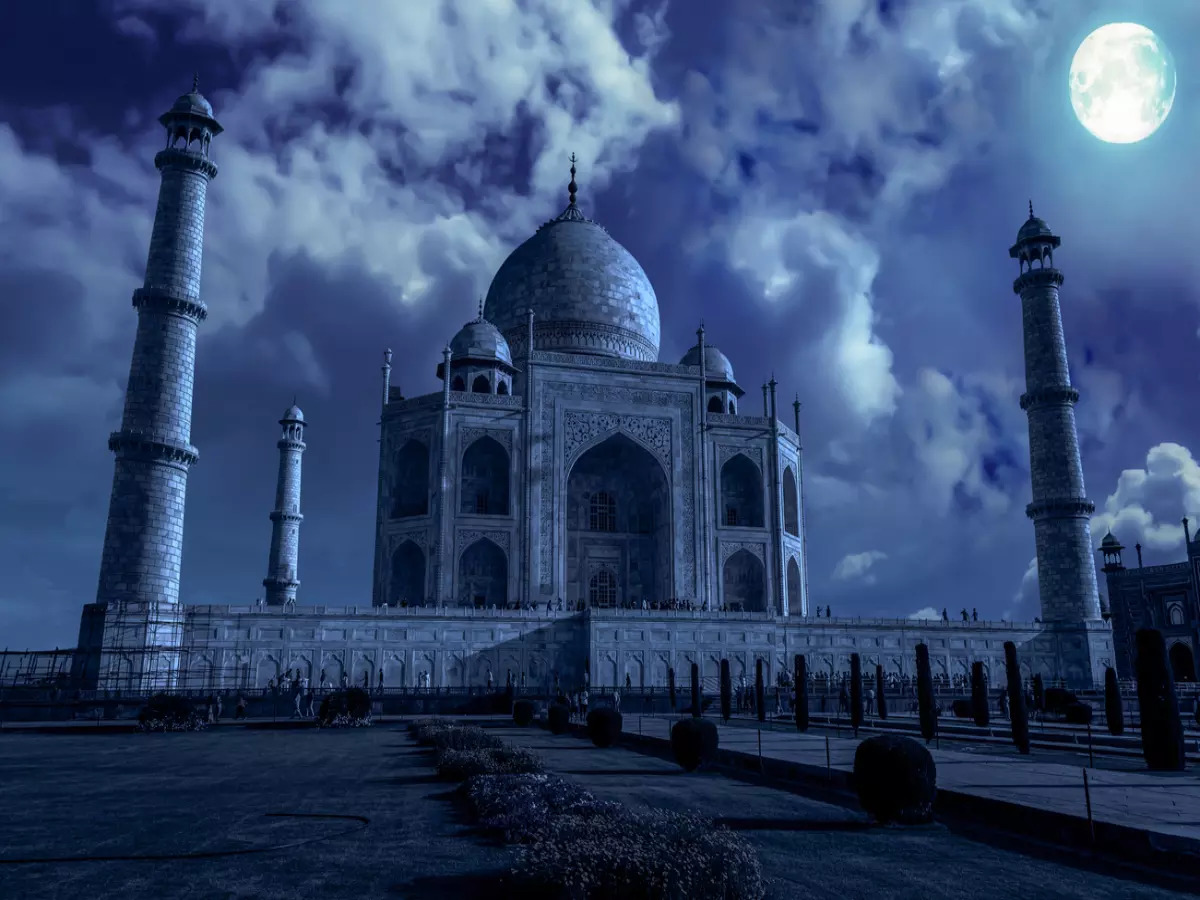Night View of Taj Mahal
The night view of Taj Mahal is one of the most mesmerizing and rare experiences in India. While millions of people visit the Taj every year, only a select few get the chance to witness its ethereal beauty under the silver glow of the moon. As daylight fades and the monument begins to shimmer under the stars, the atmosphere becomes quiet, magical, and deeply emotional. It's not just a visual experience — it's a feeling, a moment suspended in time.
Full Moon Taj Mahal
One of the most talked-about experiences in Agra is the full moon Taj Mahal viewing. The Archaeological Survey of India allows night visits for only five nights a month — the full moon night, two days before, and two days after. This limited availability makes it even more special and exclusive.
Under the full moon, the Taj Mahal takes on a surreal beauty. Its white marble gleams like polished pearl, casting soft reflections into the still waters of the Yamuna River. The intricate carvings and inlays subtly shine, and the symmetrical architecture looks even more divine under the soft, bluish hue of the moonlight.
Tickets for this experience must be booked at least 24 hours in advance, and entry is granted in small groups for a duration of 30 minutes. Though visitors are only allowed to view the monument from a distance, near the main gate, the sight is still unforgettable.
Taj Mahal in Full Moonlight
There’s something deeply poetic about witnessing the Taj Mahal in full moonlight. Built as a symbol of eternal love, this monument appears almost dreamlike at night. The silence, the soft breeze, and the luminous marble together create a calming, romantic atmosphere that simply cannot be replicated during the daytime.
The full moon casts gentle shadows across the lawns and pathways, while the central dome glows like a lantern lit from within. Every detail — from the arches and domes to the floral inlays and inscriptions — becomes subtly alive, reflecting not only the moonlight but also the timeless emotions embedded in the monument.
To truly enjoy this rare view, visitors often prefer to stay at hotels nearby that offer a clear, unobstructed view of the Taj Mahal from rooftops or balconies. Watching it in peaceful silence, far from the usual crowds, becomes a memory to cherish for life.
What Makes the Night View So Special?
Unlike the daytime buzz filled with tourists, clicking cameras, and guides shouting facts, the night view offers something deeply intimate. It’s quiet. Still. You hear the rustle of leaves, the soft sound of the wind, and the hush of the night. This setting allows visitors to connect more deeply with the monument’s soul — its story of love, loss, and legacy.
The full moon enhances the spiritual aura of the site. The marble was carefully chosen not just for its beauty, but also for its ability to reflect light — and under the moon, it truly comes alive. The Taj doesn’t just stand under the sky; it feels like it's part of it.
Important Things to Know
- Night viewing is limited: Only five days a month — on the full moon and two nights before and after.
- Tickets must be purchased in person at the Archaeological Survey of India office in Agra.
- Groups are limited to 50 people per slot, with a total of 400 visitors per night, in eight batches.
- Entry is from 8:30 PM to 12:30 AM, with each batch allowed a 30-minute stay.
- Security is strict: Carry a valid ID, and note that tripods, bags, and professional equipment are not allowed.
- The view is from a distance: Visitors see the Taj from a raised platform about 300 meters away, not from inside the complex.
Why It's Worth It
Even though you don’t get to go inside the mausoleum or walk the marble platform at night, the distant view is still magical. The lack of crowds, the softness of the moonlight, and the quiet atmosphere provide an entirely new perspective. If you’ve visited the Taj during the day, the night experience will feel like seeing an entirely different monument.
It’s a perfect option for couples, photographers, spiritual seekers, or anyone who wants to feel the deeper emotion that this place evokes.
Photography and Night Viewing
You are allowed to take photos, but with some limitations. Professional equipment, flash, and tripods are not allowed. Your best bet is to bring a good smartphone or a compact camera with a decent night mode setting.
Because of the distance and low light, photos may not turn out crystal clear, but that’s okay. The real beauty of this experience is in being there. It’s something to remember with your eyes and your heart.
Final Words
The night view of Taj Mahal is not just a tourist activity — it’s a spiritual, emotional, and unforgettable moment. Seeing one of the world’s greatest monuments bathed in moonlight reminds us why it was built in the first place: for love that transcends life and time.
So if your travel dates align with the full moon, don’t miss the chance. Plan ahead, book early, and give yourself the gift of seeing the Taj not just with your eyes, but with your soul.







